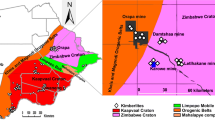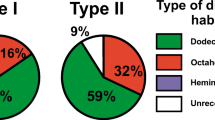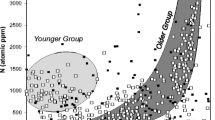Abstract
Twenty-five diamonds recovered from 21 diamondiferous peridotitic micro-xenoliths from the A154 South and North kimberlite pipes at Diavik (Slave Craton) match the general peridotitic diamond production at this mine with respect to colour, carbon isotopic composition, and nitrogen concentrations and aggregation states. Based on garnet compositions, the majority of the diamondiferous microxenoliths is lherzolitic (G9) in paragenesis, in stark contrast to a predominantly harzburgitic (G10) inclusion paragenesis for the general diamond production. For garnet inclusions in diamonds from A154 South, the lherzolitic paragenesis, compared to the harzburgitic paragenesis, is distinctly lower in Cr content. For microxenolith garnets, however, Cr contents for garnets of both the parageneses are similar and match those of the harzburgitic inclusion garnets. Assuming that the microxenolith diamonds reflect a sample of the general diamond population, the abundant Cr-rich lherzolitic garnets formed via metasomatic overprinting of original harzburgitic diamond sources subsequent to diamond formation, conversion of original harzburgitic diamond sources occurred in the course of metasomatic overprint re-fertilization. Metasomatic overprinting after diamond formation is supported by the finding of a highly magnesian olivine inclusion (Fo95) in a microxenolith diamond that clearly formed in a much more depleted environment than indicated by the composition of its microxenolith host. Chondrite normalized REE patterns of microxenolith garnets are predominantly sinusoidal, similar to observations for inclusion garnets. Sinusoidal REEN patterns are interpreted to indicate a relatively mild metasomatic overprint through a highly fractionated (very high LREE/HREE) fluid. The predominance of such patterns may explain why the proposed metasomatic conversion of harzburgite to lherzolite appears to have had no destructive effect on diamond content.










Similar content being viewed by others
References
Aulbach S, Griffin WL, Pearson NJ, O’Reilly SY, Doyle BJ (2007) Lithosphere formation in the central Slave Craton (Canada): plume subcretion or lithosphere accretion. Contrib Mineral Petrol 154:409–427
Bernstein S, Kelemen PB, Hanghøj K (2007) Consistent olivine Mg# in cratonic mantle reflects Archean mantle melting to the exhaustion of orthopyroxene. Geology 35:459–462
Bleeker W, Davis WJ (1999) The 1991–1996 NATMAP Slave province project: introduction. Can J Earth Sci 36:1033–1042
Boyd SR, Kiflawi I, Woods GS (1994) The relationship between infrared absorption and the A defect concentration in diamond. Philos Mag B 69:1149–1153
Boyd SR, Kiflawi I, Woods GS (1995) Infrared absorption by the B nitrogen aggregate in diamond. Philos Mag B 72:351–361
Brey GP, Köhler T (1990) Geothermobarmetry in four-phase lherzolites II. New thermometers, and practical assessment of existing thermobarometers. J Petrol 31:1353–1378
Bulatov V, Brey G, Foley S (1991) Origin of low-Ca, high-Cr garnets by recrystallization of low-pressure harzburgites. In: 5th international kimberlite conference extended abstracts, Araxa, pp 29–31
Burgess SR, Harte B (1999) Tracing lithosphere evolution through the analysis of heterogeneous G9/G10 garnets in peridotite xenoliths, I: Major element chemistry. In: Gurney JJ, Gurney JL, Pascoe MD, Richardson SH (eds) Proceedings of 7th international kimberlite conference, vol 1. Red roof design, Cape Town, pp 66–80
Burgess SR, Harte B (2004) Tracing lithosphere evolution through the analysis of heterogeneous G9–G10 garnets in peridotite xenoliths, II: REE chemistry. J Petrol 45:609–633
Canil D (1999) The Ni-in-garnet geothermometer: calibration at natural abundances. Contrib Mineral Petrol 136:240–246
Carlson W (2006) Rates of Fe, Mg, Mn, and Ca diffusion in garnet. Am Mineral 91:1–11
Chinn IL, Gurney JJ, Kyser KT (1998) Diamonds and mineral inclusions from the NWT, Canada. In: 7th international kimberlite conference extended abstracts, Addendum, Cape Town, p 4
Daniels LRM, Richardson SH, Menzies AH, de Bruin D, Gurney JJ (1995) Diamondiferous garnet macrocrysts in the Newlands Kimberlite, South Africa—Rosettta stones from the Kaapvaal craton keel. In: 6th international kimberlite conference extended abstracts, pp 121–123
Dawson JB, Smith JV (1975) Occurrence of diamond in a mica-garnet lherzolite xenolith from kimberlite. Nature 254:580–581
de Wit MJ (1998) On Archean granites, greenstones, cratons and tectonics: does the evidence demand a verdict? Precambrain Res 91:181–226
Deines P (2002) The carbon isotope geochemistry of mantle xenoliths. Earth Sci Rev 58:247–278
Donnelly CL, Stachel T, Creighton S, Muehlenbachs K, Whiteford S (2007) Diamonds and their mineral inclusions from the A154 South pipe, Diavik diamond mine, Northwest Territories, Canada. Lithos 98:160–176, doi:10.1016/j.lithos.2007.03.003
Griffin WL, Cousens DR, Ryan CG, Sie SH, Suter GF (1998) Ni in chrome pyrope garnets: a new geothermometer. Contrib Mineral Petrol 103:199–202
Griffin WL, Doyle BJ, Ryan CG, Pearson NJ, O’Reilly SY, Davies R, Kivi K, Van Achterbergh E, Natapov LM (1999a) Layered mantle lithosphere in the Lac de Gras area, Slave Craton: composition, structure and origin. J Petrol 40:705–727
Griffin WL, O’Reilly SY, Ryan CG (1999b) The composition and origin of sub-continental lithospheric mantle. In: Boyd FR, Fei Y, Bertka CM, Mysen BO (eds) Mantle petrology : field observations and high-pressure experimentation: a tribute to Francis R. (Joe) Boyd, Geochemical Society, Houston, pp 13–45
Griffin WL, Shee SR, Ryan CG, Win TT, Wyatt BA (1999c) Harzburgite to lherzolite and back again: metasomatic processes in ultramafic xenoliths from the Wesselton kimberlite, Kimberly, South Africa. Contrib Mineral Petrol 134:232–250
Griffin WL, O’Reilly SY, Natapov LM, Ryan CG (2003) The evolution of lithospheric mantle beneath the Kalahari Craton and its margins. Lithos 71:215–241
Grütter H, Apter DB, Kong J (1999) Crust-Mantle Coupling: Evidence from Mantle-Derived Xenocrystic Garnets. In: Gurney JJ, Gurney JL, Pascoe MD, Richardson SH (eds) Proceedings of 7th international kimberlite conference, vol 1. Red roof design, Cape Town, pp 307–313
Grütter HS, Gurney JJ, Menzies AH, Winter F (2004) An updated classification scheme for mantle-derived garnet, for use by diamond explorers. Lithos 77:841–857
Grütter H, Latti D, Menzies A (2006) Cr-saturation arrays in concentrate garnet compositions from kimberlite and their use in mantle barometry. J Petrol 47:801–820
Gurney JJ (1984) A correlation between garnets and diamonds in kimberlites. In: Glover JE, Harris PG (eds) Kimberlite occurrence and origins: a basis for conceptual models in exploration, Publication 8. Geology Department and University Extension, University of Western Australia, pp 143–166
Gurney JJ, Switzer GS (1973) The discovery of garnets closely related to diamonds in the Finsch pipe, South Africa. Contrib Mineral Petrol 39:103–116
Harley SL (1984) An experimental study of the partitioning of Fe and Mg between garnet and orthopyroxene. Contrib Mineral Petrol 86:359–373
Harris JW (1992) Diamond Geology. In: Field JE (ed) The properties of natural and synthetic diamond, Academic. London, pp 345–393
Heaman LM, Kjarsgaard BA, Creaser RA (2004) The temporal evolution of North American Kimberlites. Lithos 76:377–397
Helmstaedt H, Schulze DJ (1989) Southern African kimberlites and their mantle sample: implications for archaean tectonics and lithosphere evolution. Spec Publ Geol Soc Aust 14:358–368
Jaques AL, O’Neill HSC, Smith CB, Moon J, Chappell BW (1990) Diamondiferous peridotite xenoliths from the Argyle (AK1) lamproite pipe, Western Australia. Contrib Mineral Petrol 104:255–276
Kennedy CS, Kennedy GC (1976) The equilibrium boundary between graphite and diamond. J Geophys Res 81:2467–2470
Klein-BenDavid O, Izraeli ES, Hauri E, Navon O (2004) Mantle fluid evolution—a tale of one diamond. Lithos 77:243–253
Leahy K, Taylor WR (1997) The influence of the Glennie domain deep structure on the diamonds in the Saskatchewan kimberlites. Geol Geofiz 38:451–460
McCallum ME, Eggler DH (1976) Diamonds in an upper mantle peridotite nodule from Kimberlite in Southern Wyoming. Science 192:253–256
McCammon CA, Griffin WL, Shee SR, O’Neill HSC (2001) Oxidation during metasomatism in ultramafic xenoliths from the Wesselton kimberlite, South Africa: implications for the survival of diamond. Contrib Mineral Petrol 141:287–296
McDonough WF, Sun SS (1995) The composition of the Earth. Chem Geol 120:223–253
Menzies A, Carlson RW, Shirey SB, Gurney JJ (1999) Re–Os Systematics of Newlands Peridotite Xenoliths: implications for diamond and lithosphere formation. In: Gurney JJ, Gurney JL, Pascoe MD, Richardson SH (eds) Proceedings of 7th international Kimb conference, vol 2. Red roof design, Cape Town, pp 566–573
O’Neill HSC (1980) An experimental study of Fe–Mg partitioning between garnet and olivine and its calibration as a geothermometer: corrections. Contrib Mineral Petrol 72:337
O’Neill HSC, Wood BJ (1979) An experimental study of Fe–Mg partitioning between garnet and olivine and its calibration as a geothermometer. Contrib Mineral Petrol 70:59–70
Richardson S, Gurney J, Erlank A, Harris J (1984) Origin of diamonds in old enriched mantle. Nature 310:198–202
Ringwood AE (1991) Phase transformations and their bearing on the constitution and dynamics of the mantle. Geochim Cosmochim Acta 55:2083–2110
Ryan CG, Griffin WL, Pearson NJ (1996) Garnet geotherms: pressure-temperature data from cr-pyrope garnet xenocrysts in volcanic rocks. J Geophys Res 101:5611–5625
Schulze D (1986) Calcium anomalies in the mantle and a subducted metaserpentinite origin for diamonds. Nature 319:483–485
Schulze D (1995) Low-Ca garnet harzburgites from Kimberley, South Africa: abundance and bearing on the structure and evolution of the lithosphere. J Geophys Res 100:12513–12526
Shee SR, Gurney JJ, Robinson DN (1982) Two diamond-bearing peridotite xenoliths from the Finsch kimberlite, South Africa. Contrib Mineral Petrol 81:79–87
Sobolev NV (1974) Deep-seated inclusions in kimberlites and the problem of the composition of the upper mantle. American Geophysical Union, Washington, p 279
Sobolev NV, Pokhilenko NP, Efimova ES (1984) Diamond-bearing peridotite xenoliths in kimberlites and the problem of the origin of diamonds. Russ Geol Geophys 25:63–80
Stachel T, Harris JW (1997) Diamond precipitation and mantle metasomatism - evidence from the trace element chemistry of silicate inclusions in diamonds from Akwatia, Ghana. Contrib Mineral Petrol 129:143–154
Stachel T, Viljoen F, Brey GP, Harris JW (1998) Metasomatic processes in lherzolitic and harzburgitic domains of diamondiferous lithospheric mantle: REE in garnets from xenoliths and inclusions in diamonds. Earth Planet Sci Lett 159:1–12
Stachel T, Harris JW, Tappert R, Brey GP (2003) Peridotitic diamonds from the Slave and the Kaapvaal cratons—similarities and differences based on a preliminary data set. Lithos 71:489–503
Stachel T, Aulbach S, Brey GP, Harris JW, Leost I, Tappert R, Viljoen KS (2004) The trace element composition of silicate inclusions in diamonds: a review. Lithos 77:1–19
Taylor WR, Jaques AL, Ridd M (1990) Nitrogen-defect aggregation characteristics of some Australasian diamonds: time-temperature constraints on the source regions of pipe and alluvial diamonds. Am Mineral 75:1290–1310
Thomassot E, Cartigny P, Harris JW, (Fanus) Viljoen KS (2007) Methane-related diamond crystallization in the Earth’s mantle: stable isotope evidences from a single diamond-bearing xenolith. Earth Planet Sci Lett 257:362–371
Viljoen KS, Swash PM, Otter ML, Schulze DJ, Lawless PJ (1992) Diamondiferous garnet harzburgites from the Finsch kimberlite, Northern Cape, South Africa. Contrib Mineral Petrol 110:133–138
Viljoen F, Robinson DN, Swash PM, Griffin WL, Otter ML, Ryan CG, Win TT (1994) Diamond- and graphite-bearing peridotite xenoliths from the Roberts Victor kimberlite, South Africa. In: Meyers HOA, Leonardos OH (eds) Proceedings of 5th international kimberlite conference, vol 1. Companhia de Pesquisa de Recursos Minerais, pp 285–303
Viljoen KSF, Dobbe R, Smit B, Thomassot E, Cartigny P (2004) Petrology and geochemistry of a diamondiferous lherzolite from the Premier diamond mine, South Africa. Lithos 77:539–552
Walter MJ (1999) Melting residues of fertile peridotite and the origin of cratonic lithosphere. In: Boyd FR, Fei Y, Bertka CM, Mysen BO (eds) Mantle petrology: field observations and high-pressure experimentation: a tribute to Francis R. (Joe) Boyd. Geochemical Society, Houston, pp 225–239
Westerlund KJ, Shirey SB, Richardson SH, Carlson RW, Gurney JJ, Harris JW (2006) A subduction wedge origin for Paleoarchean peridotitic diamonds and harzburgites from the Panda kimberlite, Slave craton: evidence from Re–Os isotope systematics. Contrib Mineral Petrol 152:275–294
Acknowledgments
The authors wish to thank Sergei Matveev and GuangCheng Chen for assistance with the EPMA and LA-ICPMS analyses, respectively. This project would not have been possible without the careful collection of diamondiferous microxenoliths through Ray (Ramon) Ferraris and Delene Daniels (Production Splitting Facility of Diavik Diamond Mines). Financial support was jointly provided by NSERC and Diavik Diamond Mines in the form of a CRD grant. T.S. acknowledges support through the Canada Research Chairs program.
Author information
Authors and Affiliations
Corresponding author
Additional information
Communicated by J. Hoefs.
Electronic supplementary material
Below is the link to the electronic supplementary material.
Rights and permissions
About this article
Cite this article
Creighton, S., Stachel, T., McLean, H. et al. Diamondiferous peridotitic microxenoliths from the Diavik Diamond Mine, NT. Contrib Mineral Petrol 155, 541–554 (2008). https://doi.org/10.1007/s00410-007-0257-x
Received:
Accepted:
Published:
Issue Date:
DOI: https://doi.org/10.1007/s00410-007-0257-x




